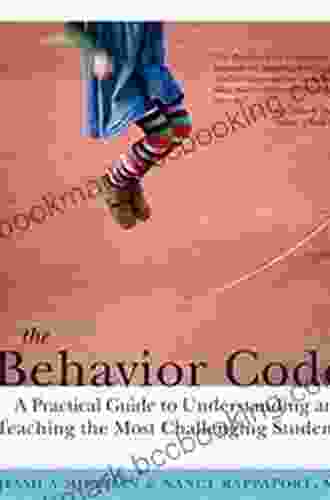Practical Guide To Understanding And Teaching The Most Challenging Students

Every teacher faces students who present challenges in the classroom. These students may have difficulty with behavior, learning, or social skills. They may be disruptive, withdrawn, or unmotivated. Dealing with these students can be frustrating and time-consuming, but it is also essential. All students deserve a quality education, and that means providing them with the support they need to succeed.
This guide provides educators with the tools and strategies they need to effectively understand and teach students who present challenges in the classroom. It covers a wide range of topics, including:
- Understanding the different types of challenges that students may face
- Developing effective behavior management plans
- Using differentiated instruction to meet the needs of all learners
- Creating a positive and inclusive classroom environment
- Working with parents and other professionals to support students
There are many different types of challenges that students may face in the classroom. Some of the most common include:
4.5 out of 5
| Language | : | English |
| File size | : | 6138 KB |
| Text-to-Speech | : | Enabled |
| Screen Reader | : | Supported |
| Enhanced typesetting | : | Enabled |
| Word Wise | : | Enabled |
| Print length | : | 280 pages |
- Behavioral challenges: These students may exhibit disruptive behaviors such as talking out of turn, being physically aggressive, or refusing to follow instructions.
- Learning challenges: These students may have difficulty with reading, writing, math, or other academic subjects. They may also have trouble understanding or following instructions.
- Social challenges: These students may have difficulty interacting with their peers. They may be shy, withdrawn, or aggressive.
- Emotional challenges: These students may experience anxiety, depression, or other emotional problems. They may also have difficulty regulating their emotions.
It is important to understand the different types of challenges that students may face in Free Download to develop effective strategies for teaching them.
Behavior management is an essential part of teaching students who present challenges in the classroom. A well-developed behavior management plan can help to reduce disruptive behaviors and create a more positive learning environment.
When developing a behavior management plan, it is important to:
- Define the problem behavior: Clearly identify the behavior that you want to change.
- Set clear expectations: Let students know what is expected of them and the consequences for breaking the rules.
- Be consistent: Enforce the rules consistently and fairly.
- Provide positive reinforcement: Reward students for good behavior.
- Use discipline sparingly: Discipline should only be used as a last resort.
There are many different behavior management techniques that you can use. Some of the most common include:
- Positive reinforcement: Rewarding students for good behavior.
- Negative reinforcement: Removing a negative consequence when a student behaves well.
- Time-out: Removing a student from the classroom for a short period of time.
- Suspension: Removing a student from school for a longer period of time.
The best behavior management technique will vary depending on the individual student and the specific behavior problem.
Differentiated instruction is a teaching approach that tailors instruction to the individual needs of students. This means providing students with different levels of support, challenge, and content.
When using differentiated instruction, it is important to:
- Assess students' needs: Determine the strengths and weaknesses of each student.
- Create flexible learning groups: Group students according to their needs.
- Provide targeted instruction: Provide instruction that is tailored to the needs of each group.
- Monitor student progress: Track student progress and make adjustments to instruction as needed.
There are many different ways to differentiate instruction. Some of the most common include:
- Content: Vary the difficulty of the content that you present.
- Process: Provide different ways for students to learn the content.
- Product: Allow students to demonstrate their learning in different ways.
Differentiated instruction can help to ensure that all students have the opportunity to succeed in the classroom.
A positive and inclusive classroom environment is essential for all students, but it is especially important for students who present challenges. A positive classroom environment is one in which students feel safe, respected, and supported.
To create a positive and inclusive classroom environment, it is important to:
- Build relationships with students: Get to know your students and their families.
- Set clear expectations: Let students know what is expected of them and the consequences for breaking the rules.
- Be consistent: Enforce the rules consistently and fairly.
- Provide positive reinforcement: Reward students for good behavior.
- Use discipline sparingly: Discipline should only be used as a last resort.
- Celebrate diversity: Value and respect the differences of all students.
A positive and inclusive classroom environment can help to reduce disruptive behaviors and create a more positive learning environment for all students.
Working with parents and other professionals is essential to supporting students who present challenges in the classroom. Parents can provide valuable information about their child's needs and strengths. They can also help to implement behavior management plans and reinforce learning at home.
Other professionals, such as special education teachers, counselors, and social workers, can also provide valuable support. These professionals can help to assess students' needs, develop behavior management plans, and provide counseling and other services.
It is important to build strong relationships with parents and other professionals. This will help to ensure that all students have the support they need to succeed in the classroom.
Teaching students who present challenges in the classroom can be a challenging but rewarding experience. By understanding the different types of challenges that students may face, developing effective behavior management plans, using differentiated instruction, creating a positive and inclusive classroom environment, and working with parents and other professionals, you can help these students to succeed.
4.5 out of 5
| Language | : | English |
| File size | : | 6138 KB |
| Text-to-Speech | : | Enabled |
| Screen Reader | : | Supported |
| Enhanced typesetting | : | Enabled |
| Word Wise | : | Enabled |
| Print length | : | 280 pages |
Do you want to contribute by writing guest posts on this blog?
Please contact us and send us a resume of previous articles that you have written.
 Book
Book Novel
Novel Page
Page Chapter
Chapter Text
Text Story
Story Genre
Genre Reader
Reader Library
Library Paperback
Paperback E-book
E-book Magazine
Magazine Newspaper
Newspaper Paragraph
Paragraph Sentence
Sentence Bookmark
Bookmark Shelf
Shelf Glossary
Glossary Bibliography
Bibliography Foreword
Foreword Preface
Preface Synopsis
Synopsis Annotation
Annotation Footnote
Footnote Manuscript
Manuscript Scroll
Scroll Codex
Codex Tome
Tome Bestseller
Bestseller Classics
Classics Library card
Library card Narrative
Narrative Biography
Biography Autobiography
Autobiography Memoir
Memoir Reference
Reference Encyclopedia
Encyclopedia Stuart Firestein
Stuart Firestein Rupert Wilkey
Rupert Wilkey Louis Hughes
Louis Hughes Lisa Hoehn
Lisa Hoehn Jen Fisch
Jen Fisch Natania Barron
Natania Barron Jenny Lundquist
Jenny Lundquist Jennifer Fandel
Jennifer Fandel Jennifer Aist
Jennifer Aist Jenson William
Jenson William Wilfred Cude
Wilfred Cude Jim Mann
Jim Mann Sonia Nieto
Sonia Nieto Joie Jager Hyman
Joie Jager Hyman Ory Slonim
Ory Slonim Jeffrey Lee
Jeffrey Lee Jerry L Ross
Jerry L Ross Jess Roche
Jess Roche Jeffery H Haskell
Jeffery H Haskell Jim Freeman
Jim Freeman
Light bulbAdvertise smarter! Our strategic ad space ensures maximum exposure. Reserve your spot today!
 Frank ButlerFollow ·8.6k
Frank ButlerFollow ·8.6k Will WardFollow ·10.7k
Will WardFollow ·10.7k James JoyceFollow ·4.2k
James JoyceFollow ·4.2k Cristian CoxFollow ·18.5k
Cristian CoxFollow ·18.5k Rodney ParkerFollow ·2.4k
Rodney ParkerFollow ·2.4k Leslie CarterFollow ·7.7k
Leslie CarterFollow ·7.7k Donald WardFollow ·11.8k
Donald WardFollow ·11.8k Roger TurnerFollow ·10.8k
Roger TurnerFollow ·10.8k

 Patrick Rothfuss
Patrick RothfussGuide for Parents: Unlocking Your Child's Problem-Solving...
As a parent, you...

 Ignacio Hayes
Ignacio HayesThe Good Girls of Al Noor: A Gripping Tale of Hope and...
On March 15, 2019, a...

 Lee Simmons
Lee Simmons50 Games and Activities for All the Turkeys at Your...
Thanksgiving is a time for family, friends,...

 Sean Turner
Sean TurnerRewiring the World: From Edison to Google - The...
A Captivating...
4.5 out of 5
| Language | : | English |
| File size | : | 6138 KB |
| Text-to-Speech | : | Enabled |
| Screen Reader | : | Supported |
| Enhanced typesetting | : | Enabled |
| Word Wise | : | Enabled |
| Print length | : | 280 pages |
















